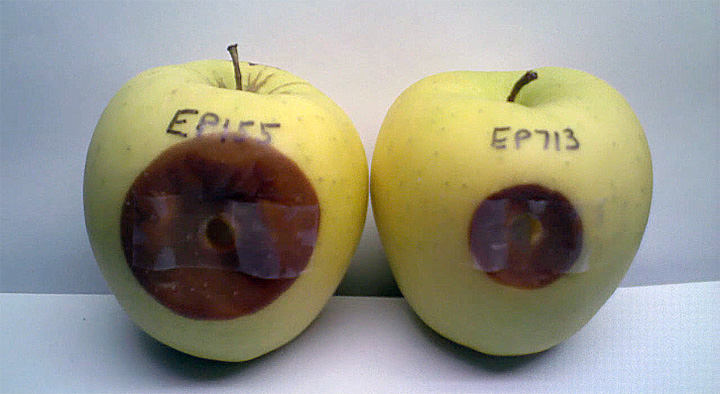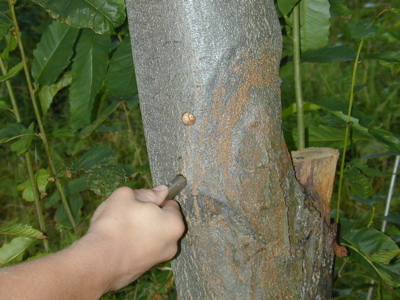The American Chestnut Project
The Search for Blight Resistance-enhancing Genes
As molecular plant pathology research advances, more and more genes are being identified with a plant's ability to defend itself against disease (see Powell et al. 2006). In order to enhance blight-tolerance in the American chestnut tree, we are studying several gene products, regulatory regions of genes to control expression (promoters), and the possibility of combining two or more genes (called stacking or pyramiding) for better and more sustainable resistance.
The first gene being tested in transgenic American chestnut encodes an enzyme called oxalate oxidase. This particular gene comes from wheat, and it is also found in many grass species. We like this gene because it is eaten daily by billions of people around the world. It is not associated with gluten found in wheat, but it is a natural defense gene that helps protect wheat from disease. It does this by detoxifying the oxalate (or oxalic acid) produced by the fungus.
Our first clue that oxalate was important came from an observation that hypovirulent fungal strains (those that can't attack the tree as well) produced far less oxalate than virulent (normal) strains of the pathogen (Havir & Anagnostakis 1983). Thus it seemed reasonable that removing the oxalate from the blight fungus (Cryphonectria parasitica) might make it less harmful to the chestnut tree. To see how reduced oxalate affects the fungus' ability to attack a plant, view the following time-lapse video of an "Apple test" used to measure fungal virulence (long version viewable on YouTube).
We have previously shown that this oxalate oxidase gene enhances tolerance to a fungal pathogen in transgenic poplar (see Liang et al. 2001). The oxalate oxidase gene is also being tested by several other researchers to enhance pathogen tolerance in plant systems such as peanut, soybean, sunflower, and oilseed rape and also to possibly increase salt tolerance in tomato. This gene was chosen for use in the American chestnut because the blight-causing fungus produces large amounts of oxalate at the margin of a canker. The oxalate oxidase enzyme can detoxify the oxalate by breaking it down to carbon dioxide and hydrogen peroxide. The hydrogen peroxide byproduct might have a second function of strengthening the lignin in the barrier produced by the chestnut in an effort to wall off the fungal infection. We have some evidence that the oxalate oxidase enzyme can enhance lignin formation (see Welch et al. 2006). This means that in addition to effectively disarming the fungus, oxalate oxidase may indirectly help the chestnut tree strengthen its naturally existing defense mechanisms.
The first transgenic American chestnut trees were planted outside in 2006. These early trees contain the wheat oxalate oxidase gene controlled by a vascular promoter, meaning the enzyme is predominantly present in the stem tissues where infections occur. We recently showed that some of these early lines feature enhanced blight resistance to levels intermediate between susceptible American chestnut and resistant Chinese chestnut (Newhouse et al. 2014). Newer lines have shown higher levels of blight resistance, similar to the Chinese chestnut (and possibly greater!), according to leaf assays and small stem assays (Zhang et al. 2013 and video).
↓ High oxalate | Low oxalate ↓

Using the OxO gene to protect the American chestnut tree has several advantages. First, it is not a pesticide and does not kill the fungus. Instead, it just neutralizes the weapon used by the fungus. In essence, this changes the lifestyle of the fungus from a pathogen to a saprophyte (pathogens attack living organisms; saprophytes only live on dead tissue). This is important because it removes the selective pressure on the fungus to overcome this tolerance-enhancing gene. Second, by targeted detoxification of the oxalate, it is unlikely to have any effect on non-target organisms that don't make this acid. Third, there is a very simple enzyme assay that can detect the presence of this gene in any chestnut tree, and thereby making blight tolerant trees easy to identify and follow in a restoration program.
The blight tolerant American chestnut trees are undergoing extensive field trials and ecological studies to ensure there are no non-target effects or harmful changes to the environment (example: D'Amico et al. 2014). With the help of several collaborators, we are evaluating potential impacts of transgenic chestnut on soil fungi, aquatic insects, terrestrial insects, other wildlife, persistence in the environment, tree growth rates, pollen flow, and surrounding plant communities. Even more ecological studies are being planned. These are being completed to prepare for Federal regulatory review by the USDA, EPA, and FDA. So far, all the data collected from these ecological studies indicates that transgenic chestnuts do not have any harmful effect on the environment, and that they are functionally no different than trees produced by traditional breeding. Our goal is to have these trees available to the public by the fall of 2023.
We have also embarked on a multi-university collaborative effort to identify the tolerance genes in Chinese chestnut (see Fagaceae genome project and the Forest Health Initiative), which could be used to transform American chestnut. These could be stacked separately or in combinations with the oxalate oxidase gene and to possibly enhance resistance to another known chestnut disease, Phytophthora root rot.
These are exciting times for American chestnut restoration but we still have more to do. As the old Chinese proverb goes, "One Generation Plants the Tree, the Next Generation Enjoys the Shade." Please join us in this first generation, so we can help the next!
Additional Reading
- D'Amico, KM, TR Horton, CA Maynard, SV Stehman, AD. Oakes, and WA Powell. 2014. Assessing Ectomycorrhizal Associations on Transgenic American Chestnut Compared to the Wild-Type, a Conventionally-Bred Hybrid, and Related Fagaceae Species. AEM (in press)
- Havir, E. A., & Anagnostakis, S. L. (1983). Oxalate production by virulent but not by hypovirulent strains of Endothia parasitica. Physiological Plant Pathology, 23(3), 369–376
- Liang, H., C.A. Maynard, R.D. Allen, W.A. Powell. 2001. Increased Septoria musiva resistance in transgenic hybrid poplar leaves expressing a wheat oxalate oxidase gene. Plant Mol. Biol. 45:619-629
- Newhouse, AE, LD McGuigan, KA Baier, KE Valletta, WH Rottmann, TJ Tschaplinski, CA Maynard, WA Powell. 2014. Transgenic American chestnuts show enhanced blight resistance and transmit the trait to T1 progeny. Plant Science (in press).
- Welch, A.J., C.A. Maynard, A.J. Stipanovic, and W.A. Powell. 2007. The effects of oxalic acid on transgenic Castanea dentata callus tissue expressing oxalate oxidase. Plant Science 172:488-496
- Zhang B, AD Oakes, AE Newhouse, KM Baier, CA Maynard and WA Powell. 2013. A threshold level of oxalate oxidase transgene expression reduces Cryphonectria parasitica - induced necrosis in a transgenic American chestnut (Castanea dentata) leaf bioassay. Transgenic Research 22, Issue 5 (2013), Page 973-982
Oxalate Oxidase Assay Video
Identifying blight resistant American chestnut trees using a sample assay to detect the oxalate detoxifying enzyme, oxo. This video is from a workshop held at the 2015 annual meeting of TACNY where the public is being taught how to perform these assays. Training people interesting n propagating these trees will significantly aid the restoration program.
Top ten reasons why we chose the oxalate detoxifying enzyme (OxO):
- The OxO gene is the most effective gene to date for enhancing blight resistance in American chestnut
- OxO is not a pesticide
- OxO is not a known allergen
- OxO is not a gluten protein
- OxO is not a toxin; in fact it detoxifies the known toxin, oxalate or oxalic acid
- OxO enzymes provide a natural defense against diseases and are found in all cereal crops and many other edible plants such as bananas and strawberries
- OxO enzymes are safely eaten by billions of people, pets, and wild animals worldwide
- OxO will be consumed in lower quantities from chestnut than from other plant sources
- OxO does not persist in the environment
- The OxO enzyme provides a simple assay for identifying the blight resistant American chestnut trees using this gene
For these reasons and more we chose the OxO to enhance blight resistance in American chestnut as part of a not-for-profit restoration program whose goal is to benefit the environment.

When is the last time you ate oxalate oxidase? Any time you ate wheat.

Sampling tissues at the margin of a blight canker on an American chestnut tree.
